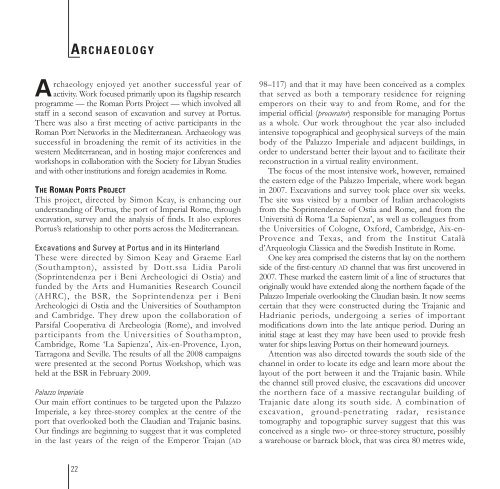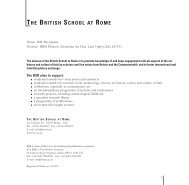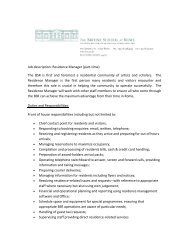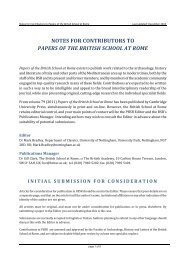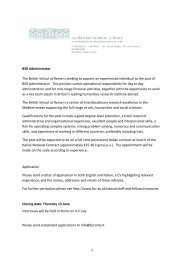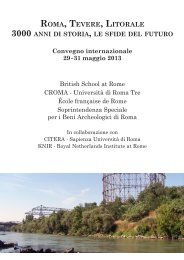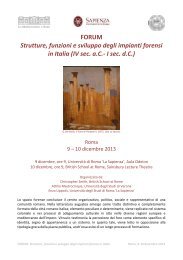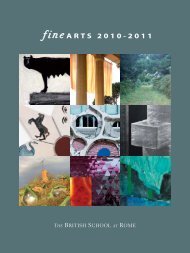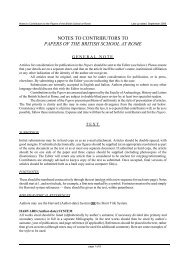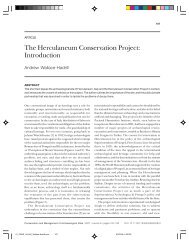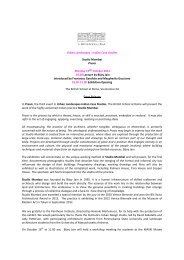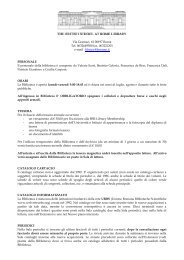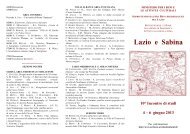Annual Report 2008-9 - The British School at Rome
Annual Report 2008-9 - The British School at Rome
Annual Report 2008-9 - The British School at Rome
Create successful ePaper yourself
Turn your PDF publications into a flip-book with our unique Google optimized e-Paper software.
A RCHAEOLOGY<br />
Archaeology enjoyed yet another successful year of<br />
activity. Work focused primarily upon its flagship research<br />
programme — the Roman Ports Project — which involved all<br />
staff in a second season of excav<strong>at</strong>ion and survey <strong>at</strong> Portus.<br />
<strong>The</strong>re was also a first meeting of active participants in the<br />
Roman Port Networks in the Mediterranean. Archaeology was<br />
successful in broadening the remit of its activities in the<br />
western Mediterranean, and in hosting major conferences and<br />
workshops in collabor<strong>at</strong>ion with the Society for Libyan Studies<br />
and with other institutions and foreign academies in <strong>Rome</strong>.<br />
THE ROMAN PORTS PROJECT<br />
This project, directed by Simon Keay, is enhancing our<br />
understanding of Portus, the port of Imperial <strong>Rome</strong>, through<br />
excav<strong>at</strong>ion, survey and the analysis of finds. It also explores<br />
Portus’s rel<strong>at</strong>ionship to other ports across the Mediterranean.<br />
Excav<strong>at</strong>ions and Survey <strong>at</strong> Portus and in its Hinterland<br />
<strong>The</strong>se were directed by Simon Keay and Graeme Earl<br />
(Southampton), assisted by Dott.ssa Lidia Paroli<br />
(Soprintendenza per i Beni Archeologici di Ostia) and<br />
funded by the Arts and Humanities Research Council<br />
(AHRC), the BSR, the Soprintendenza per i Beni<br />
Archeologici di Ostia and the Universities of Southampton<br />
and Cambridge. <strong>The</strong>y drew upon the collabor<strong>at</strong>ion of<br />
Parsifal Cooper<strong>at</strong>iva di Archeologia (<strong>Rome</strong>), and involved<br />
participants from the Universities of Southampton,<br />
Cambridge, <strong>Rome</strong> ‘La Sapienza’, Aix-en-Provence, Lyon,<br />
Tarragona and Seville. <strong>The</strong> results of all the <strong>2008</strong> campaigns<br />
were presented <strong>at</strong> the second Portus Workshop, which was<br />
held <strong>at</strong> the BSR in February 2009.<br />
Palazzo Imperiale<br />
Our main effort continues to be targeted upon the Palazzo<br />
Imperiale, a key three-storey complex <strong>at</strong> the centre of the<br />
port th<strong>at</strong> overlooked both the Claudian and Trajanic basins.<br />
Our findings are beginning to suggest th<strong>at</strong> it was completed<br />
in the last years of the reign of the Emperor Trajan (AD<br />
22<br />
98–117) and th<strong>at</strong> it may have been conceived as a complex<br />
th<strong>at</strong> served as both a temporary residence for reigning<br />
emperors on their way to and from <strong>Rome</strong>, and for the<br />
imperial official (procur<strong>at</strong>or) responsible for managing Portus<br />
as a whole. Our work throughout the year also included<br />
intensive topographical and geophysical surveys of the main<br />
body of the Palazzo Imperiale and adjacent buildings, in<br />
order to understand better their layout and to facilit<strong>at</strong>e their<br />
reconstruction in a virtual reality environment.<br />
<strong>The</strong> focus of the most intensive work, however, remained<br />
the eastern edge of the Palazzo Imperiale, where work began<br />
in 2007. Excav<strong>at</strong>ions and survey took place over six weeks.<br />
<strong>The</strong> site was visited by a number of Italian archaeologists<br />
from the Soprintendenze of Ostia and <strong>Rome</strong>, and from the<br />
Università di Roma ‘La Sapienza’, as well as colleagues from<br />
the Universities of Cologne, Oxford, Cambridge, Aix-en-<br />
Provence and Texas, and from the Institut C<strong>at</strong>alà<br />
d’Arqueologia Clàssica and the Swedish Institute in <strong>Rome</strong>.<br />
One key area comprised the cisterns th<strong>at</strong> lay on the northern<br />
side of the first-century AD channel th<strong>at</strong> was first uncovered in<br />
2007. <strong>The</strong>se marked the eastern limit of a line of structures th<strong>at</strong><br />
originally would have extended along the northern façade of the<br />
Palazzo Imperiale overlooking the Claudian basin. It now seems<br />
certain th<strong>at</strong> they were constructed during the Trajanic and<br />
Hadrianic periods, undergoing a series of important<br />
modific<strong>at</strong>ions down into the l<strong>at</strong>e antique period. During an<br />
initial stage <strong>at</strong> least they may have been used to provide fresh<br />
w<strong>at</strong>er for ships leaving Portus on their homeward journeys.<br />
Attention was also directed towards the south side of the<br />
channel in order to loc<strong>at</strong>e its edge and learn more about the<br />
layout of the port between it and the Trajanic basin. While<br />
the channel still proved elusive, the excav<strong>at</strong>ions did uncover<br />
the northern face of a massive rectangular building of<br />
Trajanic d<strong>at</strong>e along its south side. A combin<strong>at</strong>ion of<br />
excav<strong>at</strong>ion, ground-penetr<strong>at</strong>ing radar, resistance<br />
tomography and topographic survey suggest th<strong>at</strong> this was<br />
conceived as a single two- or three-storey structure, possibly<br />
a warehouse or barrack block, th<strong>at</strong> was circa 80 metres wide,


